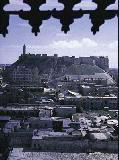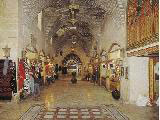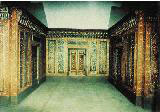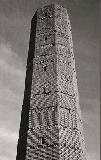Aleppo
This is the second capital of Syria (350 km north of Damascus), and one of the oldest continuously inhabited cities in history. Abraham is said to have camped on the acropolis which, long before his time, served as the foundation of a fortress (where the Aleppo citadel is standing now). He milked his grey cow there, hence Aleppo's name: "Halab al-Shahba".
Ever since the 3rd millennium B.C., Aleppo has been a flourishing city, with a unique strategic position. This position gave the city a distinctive role from the days of the Akhadian and Amorite kingdoms until modern times. It was the meeting-point of several important commercial roads in the north. This enabled Aleppo to be the link in trade between Mesopotamia, the Fertile Crescent and Egypt. The Amorites made it their capital in the 18th century B.C.
This position made it subject to invasions from various races; from Hittites, Egyptians, Assyrians, Persians, Greeks and Romans. Aleppo was prominent in the Christian era; it became a Bishopric and a huge cathedral was built in it, which is still standing.
The conflict between Byzantium and Persia, however, resulted in the latter's occupation of Aleppo in 440. The Persians robbed the city, burned considerable parts of it and damaged many of its features. Though expelled by Justinian, the Persians still threatened Aleppo and frightened its inhabitants until the Arab Islamic conquest came in 636. The city then regained its status, both cultural and commercial. Apart from the Omayyad and Abbassid periods in which Aleppo flourished the Hamadani state established by Sayf al-Dawla in 944 made Aleppo the northern capital of Syria. Sayf al-Dawla built Aleppo's famous citadel, and in his days the city enjoyed great prosperity and fame in science, literature and medicine, despite this leader's military ambitions. Mention should be made of the two most prominent poets, al-Mutanabbi and Abu al-Firas; of the philosopher and scientist, al-Farabi; and of the linguist, Ibn Khalaweh, all of whom lived in Sayf al-Dawla's court and were renowned for great knowledge and scholarship.
Aleppo was famous for its architecture; for its attractive churches, mosques, schools, tombs and baths. As an important center of trade between the eastern Mediterranean kingdoms and the merchants of Venice, Aleppo became prosperous and famous in the centuries preceding the Ottoman era. Many of its "khans" (caravanserai) are still in use even today; one of them is called "Banadiqa Khan", "Banadiqa" in Arabic being the term for "inhabitants of Venice".
In the Ottoman age, Aleppo remained an important center of trade with turkey, France, England and Holland. This caused various types of European architecture to be adopted in Aleppo which can be seen in many buildings today.
Qal'at Sam'an (Saint Simon)
This citadel is 60 km north-west of Aleppo. It was named after the hermit Saint Simon (Sam'an), a shepherd from northern Syria, who became a monk after a revelation in a dream. Following Saint Simon's death in 459, the Emperor Zenon ordered that a cathedral be built where the saint used to pray.
The layout was original, centering on the famous column from which Saint Simon used to preach. Four basilicas, arranged in the shape of a cross, opened into an octagon covered by a dome, in the center of which stood the holy column.
It is a beautiful church built on the ridge of the hill where Saint Simon had taken up "residence". Simplicity and harmony combine to make the ruins of the Basilica of St. Simon (an earthquake destroyed parts of the church less than half a century after it had been built) a masterpiece of pre-Islamic art in Syria.
In the 10th century, some towers and walls were erected. It was then called "Qal'at Sam'an" (Simon's Citadel). It became the center of conflict between Byzantium and the Hamadani kingdom; in 986, the son of Sayf al-Dawla al-Hamadani finally captured it.
The Church of Qalb Lawzi (Idleb)
Situated 65 km west of Aleppo, is the beautiful church at Qalb Lozeh. This basilica dating back to the 5th century is located in the small village of Qalb Lozeh (one of the dead cities) meaning 'Heart of the Almond', and is one of the most beautiful basilicas in Syria and is a masterpiece of Syrian Byzantine art.
It is not sure to whom this church was dedicated although it was probably used afterwards as a stopping station for pilgrims to St. Simeon's church like the nearby church of Mshabak.
This magnificent church contains three basilica aisles with a narthex stands in a wild setting. The entrance to this basilica has a tower on each side three stories high, which used to frame a semicircular arch. The inside of the church is divided into three naves. Each two naves are separated between a row of three arches. The circular rear part of the church has two orders of columns. The upper floor of the central nave has windows on both sides; small columns separate these windows.
The beautiful architecture used in this church shows an ability to use classical Greek decoration.
Ebla (Tal Mardikh - Idleb)
This "Tal" is 25 km south-east- of Idleb. It is the site of important and recent archaeological discoveries. Excavations in the "Tal" have revealed a very old Syrian civilization, that of Ebla, which flourished in the 3rd and 2nd millenniums B.C.
In the palace of this great kingdom, a library containing more than 17,000 clay tablets was uncovered. These tablets are the earliest written documents in Syria.











